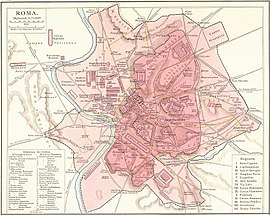Porta Pinciana
 External view of Porta Pinciana | |
 Click on the map for a fullscreen view | |
| Location | Rome |
|---|---|
| Coordinates | 41°54′34″N 12°29′18″E / 41.90944°N 12.48833°E |
Porta Pinciana is a gate of the Aurelian Walls in Rome.[1]
The name derives from the gens Pincia, who owned the eponymous hill (Pincian Hill). In ancient times it was also called Porta Turata ("Plugged Gate", for it was partially closed) and Porta Salaria vetus, as the oldest Via Salaria passed under it (the Via Salaria nova passed under the Porta Salaria).
The gate was built under the emperor Honorius in the early 5th century.[2]
During the Middle Ages a legend told that the Byzantine general Belisarius, who here had defended Rome against the Ostrogoths in the siege of 537–538, was refused admission by the Romans.[2]
The two side passages are a modern addition. The gate remained closed until the early 20th century.
See also
- Porta del Popolo – Gate of the Aurelian walls, a landmark of Rome, Italy
- List of ancient monuments in Rome
Notes
References
- Platner, Samuel Ball; Ashby, Thomas (1929). "A Topographical Dictionary of Ancient Rome.". London: Oxford University Press. Retrieved 8 June 2022.
- Parker, John Henry (1874). The archaeology of Rome. Retrieved 8 June 2022.
External links
- Lucentini, M. (31 December 2012). The Rome Guide: Step by Step through History's Greatest City. Interlink. ISBN 9781623710088.
 Media related to Porta Pinciana (Rome) at Wikimedia Commons
Media related to Porta Pinciana (Rome) at Wikimedia Commons
| Preceded by Porta Pia |
Landmarks of Rome Porta Pinciana |
Succeeded by Porta del Popolo |
This article contains text from Platner and Ashby's A Topographical Dictionary of Ancient Rome, a text now in the public domain.

